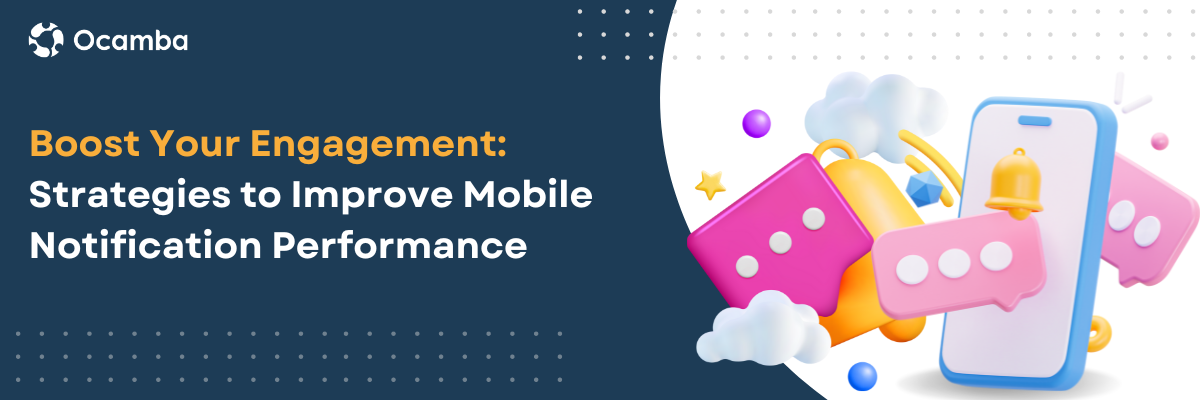Boost Your Engagement: Strategies to Improve Mobile Notification Performance

Introduction
In today’s mobile-driven world, push notifications have become vital for enhancing user engagement. With the ever-increasing number of mobile apps and websites competing for users’ attention, push notifications are a powerful means of reaching and re-engaging audiences.
Ocamba recognizes the significance of mobile push notifications in connecting with its user base. With its various features, you can rely on its push notification system to inform users about new product arrivals, exclusive offers, personalized recommendations, and time-sensitive deals.
By leveraging push notifications, we aim to create a seamless user experience, providing timely and relevant updates to users’ mobile devices, ultimately driving engagement and fostering customer loyalty.
Key strategies to enhance mobile notification performance
When it comes to enhancing mobile notification performance, personalization is a crucial strategy that can significantly impact user engagement. This way, businesses can create a more tailored and relevant user experience.
By collecting user data and preferences, such as browsing history, purchase behavior, and demographic information, you can gain insights into individual user preferences and interests.
Personalized push notifications have a higher chance of grabbing users’ attention, driving engagement, and ultimately leading to higher conversion rates. Understanding these factors enables you to tailor push notifications to align with user interests and preferences.
Segmentation plays a vital role in maximizing the impact of personalized push notifications. By dividing users into specific segments based on demographics, purchase history, or browsing behavior, companies can deliver messages that cater to each piece’s unique needs and preferences.
For example, on Ocamba, you can create segments based on user preferences for specific product categories or shopping habits. This lets you send targeted notifications about relevant sales, new arrivals, or exclusive discounts.
Segmenting users ensures that push notifications are highly targeted and resonate with users, increasing the likelihood of engagement and conversions.
Optimizing Push Notifications
By carefully considering timing and frequency, conducting A/B testing, optimizing by user time zone, and implementing quiet hours, businesses can enhance the performance of their mobile push notifications.
These strategies ensure that messages are delivered at the right time, in the correct quantity, and with the right level of personalization, ultimately leading to increased user engagement and satisfaction.
Timing and frequency
Timing and frequency are critical factors in maximizing the effectiveness of mobile push notifications. Getting the timing right ensures that messages reach users when they are most likely to engage with them.
By monitoring metrics such as app usage data and engagement trends, you can identify the optimal times when users are most active and receptive to messages. Sending notifications during these peak activity periods increases the chances of capturing users’ attention and driving desired actions.
While timing is essential, avoiding overloading users with excessive notifications is equally crucial. Bombarding users with a high frequency of messages can lead to annoyance and potentially result in users opting out or disabling notifications altogether. To strike the right balance, businesses should consider each message’s relevance and value carefully.
A/B testing
Conducting A/B testing is an effective strategy to optimize push notifications. By dividing users into various groups and sending messages with different content, businesses can compare the performance metrics of each group.
A/B testing allows you to evaluate the impact of different notification elements on open rates, click-through rates, and overall engagement. Based on the results, businesses can refine their notification strategies and identify the optimal timing, frequency, and content that yield the best results for their specific user base.
Optimize by user time-zone
Optimizing push notifications based on user time zones is another important consideration. Users are located in different regions and time zones, and sending messages at the right time for each user’s location increases the likelihood of engagement.
By leveraging user data and location information, businesses can customize the delivery time of push notifications to align with users’ local time zones. This personalized approach demonstrates thoughtful consideration for users’ preferences and enhances the overall user experience.
Quiet hours
Implementing quiet hours is another strategy to respect users’ preferences and avoid intrusive notifications. Quiet hours refer to designated periods during which businesses refrain from sending push notifications, typically during late night or early morning hours when users are more likely to be resting or less receptive to messages.
By implementing quiet hours, businesses show consideration for users’ time and maintain a positive user experience, ultimately fostering trust and engagement.
Compelling content
Compelling content is essential for capturing users’ attention and driving engagement with mobile push notifications. By crafting attention-grabbing and concise notification messages, you can increase the likelihood of users opening and interacting with the announcements.
To create attention-grabbing content, notifications should be concise and to the point. Focus on conveying the essential information or value proposition to capture users’ interest and entice them to take action.
Using persuasive language and strong calls-to-action (CTAs) is another effective strategy. Including compelling CTAs encourages users to take the desired action, such as clicking through to a promotional offer, making a purchase, or exploring new products.
Incorporating visual and multimedia elements can significantly enhance the impact of push notifications. By including eye-catching images, videos, or GIFs, businesses can make their messages more visually appealing and engaging. Visual elements can convey information more effectively, evoke emotions, and create a memorable impression.
To expand reach and engagement, translating notifications into other languages is crucial. Ocamba can cater to diverse users by providing messages in multiple languages. Translating announcements ensures that all users can understand and engage with the content regardless of their preferred language.
Key benchmarks to follow
Mobile push notifications are a powerful tool for engaging users and driving desired actions. Tracking key benchmarks that provide insights into their performance is essential to optimize your push notification strategy.
Let’s explore the essential criteria that app owners should follow when evaluating the effectiveness of their mobile push notifications, supported by industry statistics.
Delivery Speed: On average, push notifications should be delivered to devices within a few seconds of being sent. Prompt delivery ensures users receive messages promptly. According to industry data, the average delivery time for push notifications is approximately 5 seconds.
Delivery Success Rate: Monitoring the delivery success rate is crucial for evaluating the effectiveness of push notifications. Aim for a delivery success rate of around 95% or higher. This means that your messages reach most of your intended audience successfully.
Click-Through Rate (CTR): CTR measures the percentage of users who click on push notifications. By crafting compelling content and strong calls to action, you can increase the likelihood of users engaging with your notifications.
Opt-In Rate: The opt-in rate measures the percentage of users who agree to receive push notifications. The average opt-in rate across industries is approximately 40% to 50%. Aim to optimize your opt-in process to encourage more users to subscribe and receive your notifications.
Open Rate: Open rate represents the percentage of users who open push notifications. Benchmark your open rate to assess the effectiveness of your notifications in capturing users’ attention.
Retention Rate: The retention rate measures the percentage of users who continue to engage with your app or website after receiving push notifications. Continuously analyzing and optimizing your notification strategies can help improve user retention.
Conversion Rate: The conversion rate measures the percentage of users who complete a desired action after clicking on a push notification. Monitoring and improving your conversion rate is essential for evaluating the impact of your stranotifications on driving user actions.
Personalization Effectiveness: Personalization is a crucial aspect of push notifications. According to studies, personalized messages have improved click-through rates by up to 800%. Assess user satisfaction and engagement with customized notifications through feedback and surveys to refine your personalization strategies.
Response Time: Response time refers to users interacting with push notifications after receiving them. According to industry benchmarks, a low response time, such as within the first minute, can lead to higher engagement rates and increased conversions.
Uninstall Rate: Monitoring the uninstall rate is crucial to evaluate the impact of push notifications on user retention. The average uninstall rate varies across industries but ranges from 2% to 5%. Keeping the uninstall pace low ensures your messages are not perceived as intrusive or irrelevant.
Conclusion
Improving the performance of mobile push notifications requires a strategic approach and continuous optimization. By implementing the key strategies outlined in this blog post, businesses can enhance the effectiveness of their messages and drive higher user engagement.
Personalization, timing and frequency, compelling content, translation, and benchmarking against crucial metrics are all critical elements to consider.
Continuously evaluating and refining your push notification strategy can enhance user engagement, increase conversions, and ultimately drive the success of your mobile app.















 www.ocamba.com
www.ocamba.com